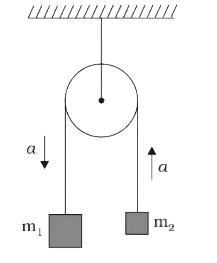The expression to compute molar mass of an ideal non volatile solute M2 from the depression in freezing point mass of solute m2, and mass of solvent m1, isSolution in Malayalam
M2=1000KAΔTfm1m2
M2=DetlaTf1000Kfm2m1
M2=ΔTf1000Kfm1m2
M2=1000KfΔTfm2m1
The correct Answer is:D
Step by step video, text & image solution for The expression to compute molar mass of an ideal non volatile solute M_2 from the depression in freezing point mass of solute m_2, and mass of solvent m_1, is by Chemistry experts to help you in doubts & scoring excellent marks in Class 12 exams.
Updated on:21/07/2023Topper's Solved these Questions
- SOLUTIONSBOOK - BRILLIANT PUBLICATIONCHAPTER - SOLUTIONSEXERCISE - Level-II
50 Videos
- SOLUTIONSBOOK - BRILLIANT PUBLICATIONCHAPTER - SOLUTIONSEXERCISE - Level -III (Single Correct Answer Type)
8 Videos
- SOLUTIONSBOOK - BRILLIANT PUBLICATIONCHAPTER - SOLUTIONSEXERCISE - QUESTION (LEVEL -II) (ASSERTION-REASON)
5 Videos
- SOLID STATEBOOK - BRILLIANT PUBLICATIONCHAPTER - SOLID STATEEXERCISE - LEVEL-3 (Linked Comprehension Type)
10 Videos
- STEREOCHEMISTRY BOOK - BRILLIANT PUBLICATIONCHAPTER - STEREOCHEMISTRY EXERCISE - LEVEL-II (ASSERTION - REASON TYPE)
2 Videos
Similar Questions
The volumes of two HCl solutions A (0.5N) and B(0.1N) to be mixed for preparing 2 L of 0.2 NHCl are:
View SolutionTwo components A and B form an ideal solution. The mole fractions of A and B in solution are XAandXB, while that in vapour phase are YAandYB. The slope and intercept of plot of 1YA vs 1XA will be
View SolutionAssertion: van't Hoff factor for benzoic acid in benzene is less than one
Reason: Benzoic acid behave as a weak electrolytein benzene.
View SolutionF centre is an example of metal excess defect due to the presence of extra cations at interstitial sites. Zinc oxide is white in colour at room temperature, on heating it loses oxygen and turns yellow.
ZnOHeat−−→Zn2++12O2+2e−
Now there is excess of zinc in the crystal and its formula becomes Zn1+x O. the excess of Zn2+ ions move to interstitial sites and the electrons to neighbouring interstitial sites.
There are many solids which are difficult to prepare in the stiochiometric composition and contain less amount of the metal as compared to stiochiometric proportion. a typical example of this type is FeO which is mostly found with a composition of Fe0.95. it may actually range from Fe0.96 O.
Q. In Fe0.95 O:
View SolutionAssertion : Meso tartaric acid is optically inactive
Reason : Meso tartaric acid has a plane of symmetry
View SolutionThe centre of mass of a system of two particle of masses m_1 and m_2 is at a distance d_1 from m_1 and at a distance d_2 from mass m_2 such that.
View SolutionFind the acceleration of centre of mass of the blocks of masses m1,m2(m1>m2) in Atwood's machine.
View SolutionTwo bodies of masses m_1 and m_2(
View SolutionIf two masses m_1 and m_2 (m_1 gt m_2) tied to string moving over a frictionless pulley, then acceleration of masses
View SolutionGravitational force between masses m1 and m2 is F. If a third mass m3 is placed near m1 and m2, then the force between m1 and m2 would be
View SolutionGravitational force between masses m_1 and m_2 is F. If a third mass m_3 is placed near m_2 and m_3 then the force between m_1 and m_2 would be
View SolutionThe centre of mass of a system of two particle of masses m1andm2 is at a distance d1 from mass m1 and at a distance d2 from mass m2 such that.
View SolutionHow can you determine the molecular mass of a non-volatile solute from depression of freezing point ?
View SolutionExplain depression in freezing point. How depression in freezing point can be used to find molar mass of a non-volatile solute? Define molal depression constant.
View SolutionWhy is freezing point depressed when a non-volatile solute is added to a solvent ?
View SolutionTwo bodies of masses m1andm2(<m1) are connected to the ends of a massless cord and allowed to move as shown in figure. The pulley is both massless and frictionless. The acceleration of the centre of mass is (m1−m2)n(m1+m2)2g. Find the value of n.

View Solution
